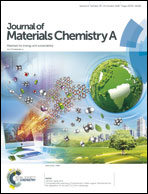Synergistic optimization of carrier transport and thermal conductivity in Sn-doped Cu2Te†
Abstract
Pristine Cu2Te is a highly degenerate metallic-behaving semiconductor that exhibits poor thermoelectric performance due to its ultrahigh hole concentration derived from the intrinsically high concentration of cation vacancies. Here, through doping with Sn, the electronic transport properties of Cu2−xSnxTe are significantly promoted due to the hole concentration reduction stemming from more valence electrons being contributed by Sn; the thermal conductivity is simultaneously decreased for the same reason. Consequently, a record high zT of 1.5 was achieved in p-type Cu1.90Sn0.10Te at 1000 K, which is due to a synergistic optimization in power factor and thermal conductivity. Combined with the density functional theory (DFT) calculations, such an improvement could be mainly attributed to the increase in the density of states (DOS) in the valence band edge of Cu2−xSnxTe, which originated from the hybridization of the lone pair electrons of the Sn 5s orbital with the Cu 3d and Te 5p electrons. Additionally, transmission electron microscopy revealed the existence of a high density of twist boundaries and dislocations that may have enhanced the phonon scattering, therefore, contributing to the reduced thermal conductivity. This study explores a synergistic optimization strategy to simultaneously boost the power factor and suppress thermal conductivity, providing a feasible method to achieve high thermoelectric performance in intrinsically highly degenerate semiconductors with metallic behavior.



 Please wait while we load your content...
Please wait while we load your content...